Hoa Lu Ancient Capital might be less known, but it’s a treasure trove of Vietnam’s early history. Situated in the breathtaking Ninh Binh province, this site served as Vietnam’s capital over a thousand years ago.
The ancient citadel offers visitors a serene journey through time, with its well-preserved temples and stunning natural surroundings. Visitors can walk among centuries-old structures that whisper stories of Vietnam’s past, set against a backdrop of dramatic limestone landscapes.
Let’s discover what makes Ancient Capital so unique and why this place truly deserves a spot on your list of unmissable destinations when visiting Vietnam.
1. Hoa Lu Ancient Capital Overview
Hoa Lu Ancient Capital served as the political, cultural, and economic center of Vietnam from 968 to 1010, during the reigns of the Dinh, Early Le, and Ly dynasties. Spanning an area of approximately 300 hectares, this ancient kingdom, known as Dai Co Viet, was strategically chosen for its natural defenses. Surrounded by the Trang An limestone mountains and the Hoang Long River, Hoa Lu Ancient Capital was a fortress that protected the kingdom from invaders, particularly during a time of frequent conflicts with Chinese forces.
Today, Hoa Lu Ancient Capital is a UNESCO-recognized site, forming one of the four core areas of the Trang An Scenic Landscape Complex. While much of the original citadel has succumbed to time, the site remains a significant historical and cultural landmark, featuring ancient temples, royal tombs, and stunning natural scenery. Visitors to Hoa Lu Ancient Capital can explore the remnants of Vietnam’s first imperial dynasties while soaking in the serene beauty of Ninh Binh’s limestone karsts, rivers, and lush greenery.
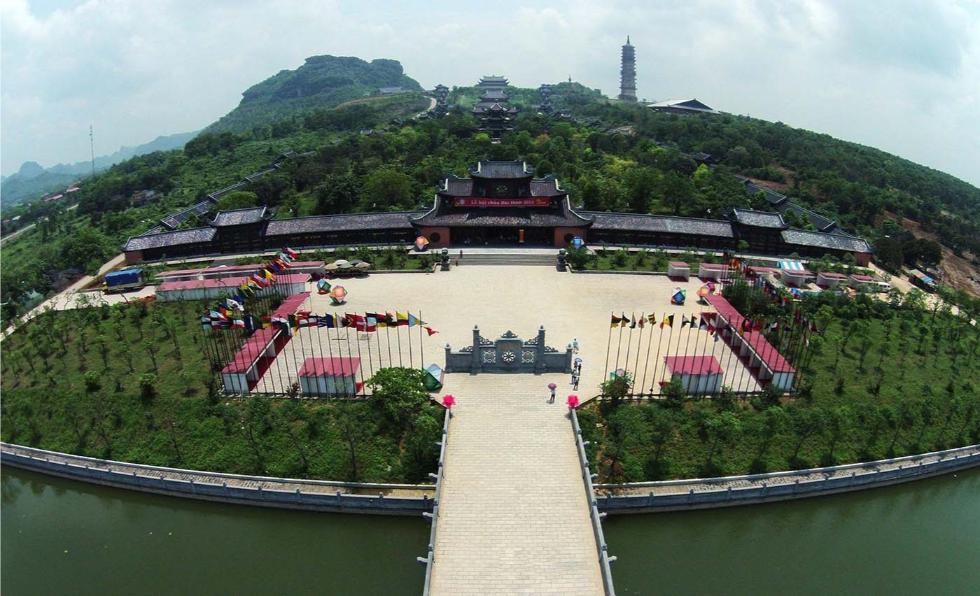
Hoa Lu Ancient Capital Vietnam: a historical complex of Vietnam (Source: Collected)
2. Location and How to Get to Hoa Lu, Vietnam
Hoa Lu Ancient Capital is located in Truong Yen Commune, Hoa Lu District, Ninh Binh Province, Vietnam. It lies approximately 90–100 kilometers south of Hanoi, making it an accessible day trip from the capital city. The area is surrounded by the picturesque Trang An limestone mountains, often referred to as “Halong Bay on land” due to its dramatic karst landscape.
2.1. How to Get to Hoa Lu Ancient Capital
There are several convenient ways to travel to Hoa Lu Ancient Capital from Hanoi or other nearby destinations:
- By Car or Taxi: The most comfortable option is to travel by private car or taxi. The journey from Hanoi to Hoa Lu Ancient Capital takes about 2 hours, covering a distance of around 100 kilometers. You can hire a private car or use ride-hailing apps for a hassle-free trip.
- By Bus: Several buses operate daily between Hanoi and Ninh Binh. From Hanoi’s Giap Bat or My Dinh Bus Station, the bus ride takes approximately 2.5 to 3 hours, with tickets costing around 4–6 USD per person. Once in Ninh Binh, a short taxi ride will take you to Hoa Lu Ancient Capital.
- By Train: For a scenic journey, you can take a train from Hanoi to Ninh Binh. Trains depart from Hanoi Railway Station and take about 2 to 3 hours to reach Ninh Binh. From there, a taxi or motorbike ride will get you to Hoa Lu Ancient Capital in about 15 minutes.
- By Motorbike or Bicycle: If you’re staying in Ninh Binh or nearby areas like Tam Coc or Trang An, renting a motorbike or bicycle is a popular option. The flat terrain makes cycling an enjoyable way to reach Hoa Lu Ancient Capital, which is about 12 kilometers from Ninh Binh city center.
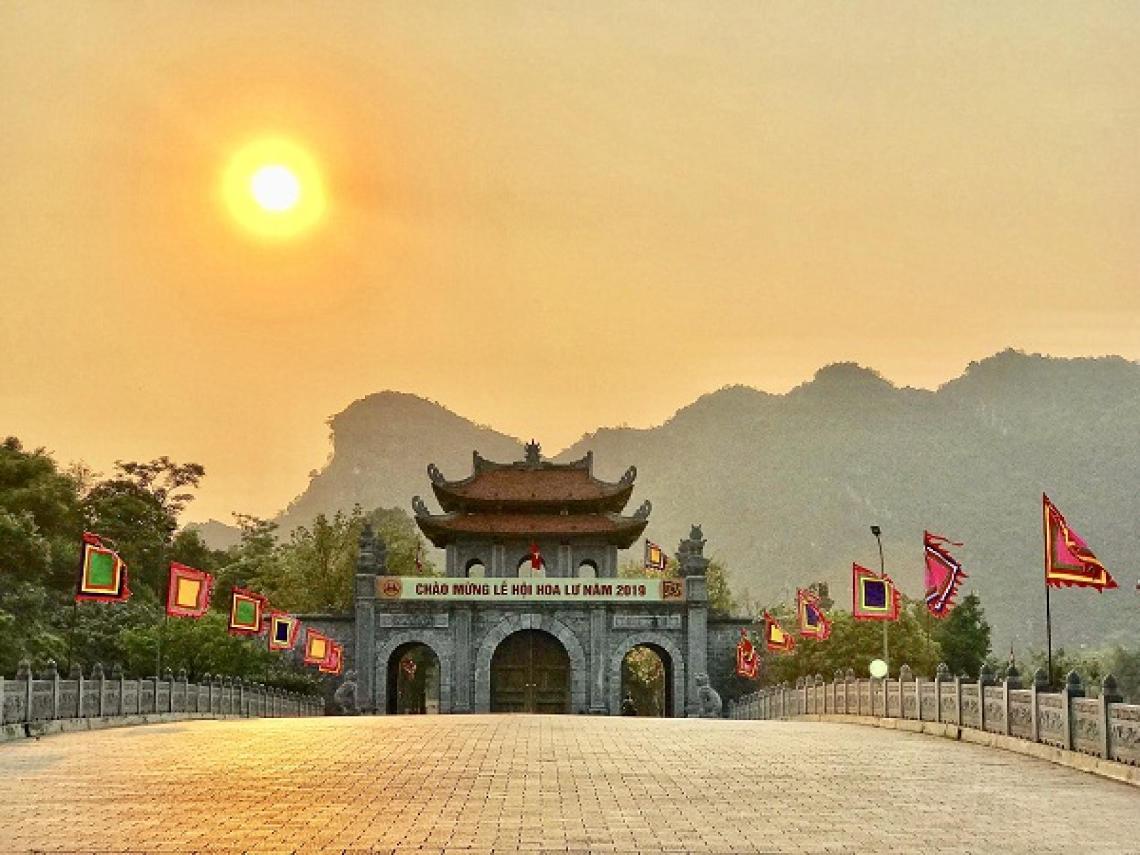
There are several convenient ways to travel to Hoa Lu Ancient Capital (Source: Collected)
3. Learn about the History of Hoa Lu Ancient Capital Vietnam
The history of Hoa Lu Ancient Capital Vietnam is a fascinating tale of resilience, power, and cultural development. In 968, Dinh Bo Linh, a local warlord, unified the country after defeating 12 rival warlords and proclaimed himself Emperor Dinh Tien Hoang, founding the Dinh Dynasty. He established Hoa Lu as the capital of Dai Co Viet, marking the beginning of Vietnam’s first centralized feudal state after centuries of Chinese domination.
Hoa Lu Ancient Capital was chosen for its strategic location, surrounded by limestone mountains and the Hoang Long River, which provided natural defenses against invaders. Dinh Tien Hoang’s reign ended tragically in 979 when he was assassinated, leaving his six-year-old son, Dinh Toan, as emperor. Le Hoan, a top general under Dinh Tien Hoang, became regent and later declared himself emperor, founding the Early Le Dynasty in 980.
The Early Le Dynasty ruled from Hoa Lu until 1009, when Le Long Dinh, the last Le emperor, passed away.
In 1010, Ly Thai To, the founder of the Ly Dynasty, moved the capital to Thang Long (modern-day Hanoi), seeking fertile lands in the Red River Delta to support a growing population. Hoa Lu then became an “ancient capital,” but it remained a significant military and spiritual center in the centuries that followed.
Today, Hoa Lu Ancient Capital stands as a symbol of Vietnam’s early dynastic history, preserving the legacy of the Dinh and Le dynasties through its temples, pagodas, and cultural traditions.
4. What to Know Before Visiting Hoa Lu Ancient Capital
Before embarking on your journey to Hoa Lu Ancient Capital, here are some essential details to help you plan your visit.
4.1. Opening Hours
Hoa Lu Ancient Capital is open daily from 7:00 AM to 5:00 PM. It’s best to arrive early in the morning to avoid the midday heat and enjoy a quieter experience, especially if you plan to explore the temples and surrounding areas on foot.
4.2. Ticket Price
The entrance fee to Hoa Lu Ancient Capital is affordable, costing 20,000 VND (approximately 1 USD) per person. This ticket grants access to the main historical sites, including the temples of King Dinh Tien Hoang and King Le Dai Hanh. Additional fees may apply for activities like boat rides or guided tours in the surrounding areas.
4.3. Best Time to Visit
You can visit Hoa Lu Ancient Capital year-round, but the best time to experience its beauty and cultural vibrancy is during spring (February to April). This period coincides with the annual Truong Yen Festival, held from the 8th to the 10th of the third lunar month (around March or April). The festival features traditional ceremonies, games, and performances, offering a lively glimpse into local culture.
If you prefer a more peaceful visit, consider traveling during the quieter months, such as May or September. Early summer (May) is also a great time to witness the golden rice fields during the harvest season, adding a picturesque charm to your trip. Avoid visiting during the rainy season (June to August), as the area can become slippery and less accessible.

You can visit Hoa Lu Ancient Capital year-round (Source: Collected)
5. 6 Things to Do and See in Hoa Lu Ancient Capital
Hoa Lu Ancient Capital offers a wealth of historical and cultural attractions, as well as opportunities to connect with nature and local traditions. Here are six must-do activities and sights to explore during your visit.
5.1. Temple of King Dinh Tien Hoang
The Temple of King Dinh Tien Hoang is one of the most significant landmarks in Hoa Lu Ancient Capital. Built in the 17th century on the grounds of the former royal palace, this temple honors Dinh Bo Linh, the founder of the Dinh Dynasty and Vietnam’s first emperor. The temple is designed in the traditional “noi cong ngoai quoc” style, with a river to the front and Ma Yen Mountain at the back, adhering to feng shui principles.
Inside, the temple features three shrines: the outer Ngo Mon Gate, the middle Thien Huong shrine, and the inner sanctum, where a statue of Dinh Tien Hoang sits on a throne, flanked by statues of his three sons. The temple’s intricate wood and stone carvings, crafted by Vietnamese artisans, reflect the architectural brilliance of the era. A small museum on the grounds displays black-and-white photos and artifacts related to Hoa Lu Ancient Capital, offering deeper insights into its history.
5.2. Temple of King Le Dai Hanh
Located about 200 meters north of the Dinh Tien Hoang Temple, the Temple of King Le Dai Hanh is another highlight of Hoa Lu Ancient Capital. This temple, also built in the 17th century, honors Le Hoan, the founder of the Early Le Dynasty and a military hero who defended Vietnam against Chinese invasions. The temple shares a similar architectural style to the Dinh Tien Hoang Temple but is slightly smaller in scale.
The temple complex consists of three parts: the front shrine, Thien Huong House, and the sanctum, where statues of Le Dai Hanh, his wife, and his son Le Long Dinh are enshrined. The temple is set against the backdrop of Den Mountain, creating a serene and spiritual atmosphere. Visitors can light incense to pay respects to the king and learn about his contributions to Vietnam’s independence.
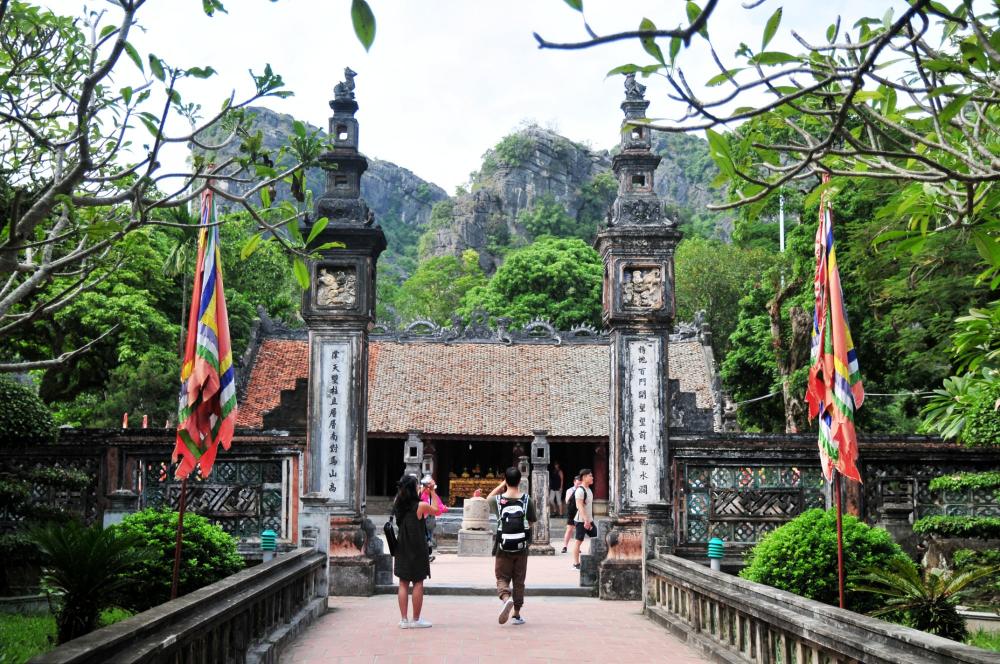
Visiting King Dinh and Le Temple is one of the first things to grasp before starting your tour (Source: Collected)
5.3. Nhat Tru Pagoda
Nhat Tru Pagoda, often referred to as the “One-Pillar Pagoda” of Hoa Lu, is a spiritual gem within the Hoa Lu Ancient Capital complex. Built in 995 during the Early Le Dynasty, the pagoda is known for its minimalist yet striking design, featuring a single stone pillar. The pagoda served as a gathering place for monks and mandarins to discuss national matters, making it a significant site in Vietnam’s spiritual and political history.
Spanning 3,000 square meters, Nhat Tru Pagoda offers a peaceful atmosphere for meditation and reflection. The pagoda houses ancient Buddhist relics, including a stone pillar with Buddhist laws carved on it, which is considered a national treasure. A visit to Nhat Tru Pagoda provides a deeper understanding of the spiritual heritage of Hoa Lu Ancient Capital.
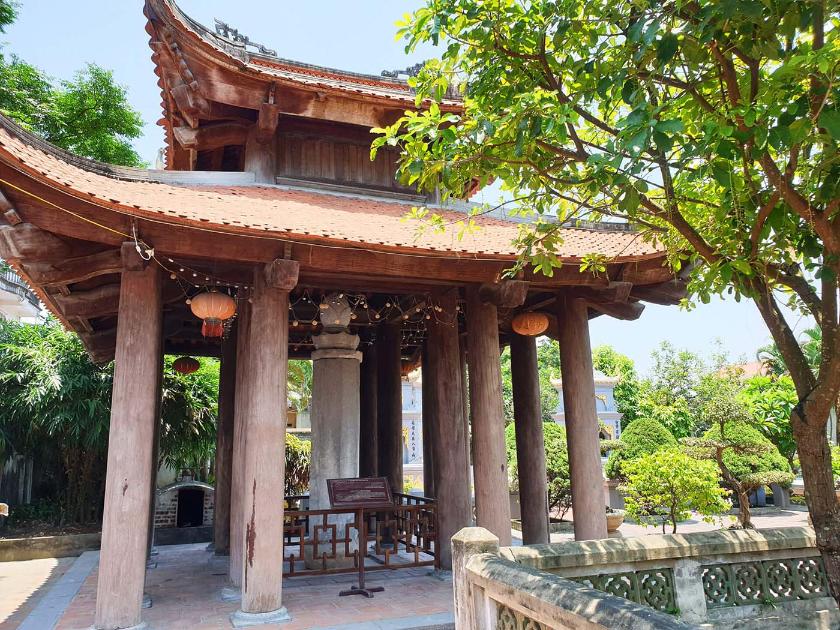
Nhat Tru Pagoda is one of the most famous attractions in Hoa Lu (Source: Collected)
5.4. Hoa Lu Tu Tran (Four Sacred Temples of Hoa Lu)
Hoa Lu Ancient Capital is renowned for its four sacred temples, known as Hoa Lu Tu Tran, which are dedicated to the gods of the four cardinal directions. These temples—Nguyen Temple (North), Quy Minh Temple (South), Thien Ton Temple (East), and Cao Son Temple (West)—are spread across the region and hold deep spiritual significance for locals. Each temple offers a unique glimpse into Vietnam’s spiritual traditions and architectural styles.
Visiting these temples allows you to offer incense, commemorate the gods, and experience the spiritual life of the local community. The temples are also surrounded by stunning natural scenery, making them perfect spots for photography and quiet contemplation.
5.5. Am Tien Cave
Am Tien Cave, also known as Tuyet Tinh Coc, is a hidden gem located about 400 meters from the Dinh Tien Hoang Temple. This cultural and natural site is nestled within the Trang An Complex and features a harmonious blend of limestone mountains, a tranquil lake, and a small pagoda. The cave is accessible after climbing 205 stone steps, offering breathtaking views of the surrounding landscape.
Am Tien Cave is steeped in history and legend. It is said to have been the site of the Vong Nguyet Palace, where Princess Phat Kim, the daughter of Dinh Tien Hoang, once resided. After enduring personal hardships, the princess is believed to have taken her life by jumping into a well near the cave, which still exists today. A visit to Am Tien Cave offers a mix of natural beauty and historical intrigue, making it a must-see in Hoa Lu Ancient Capital.
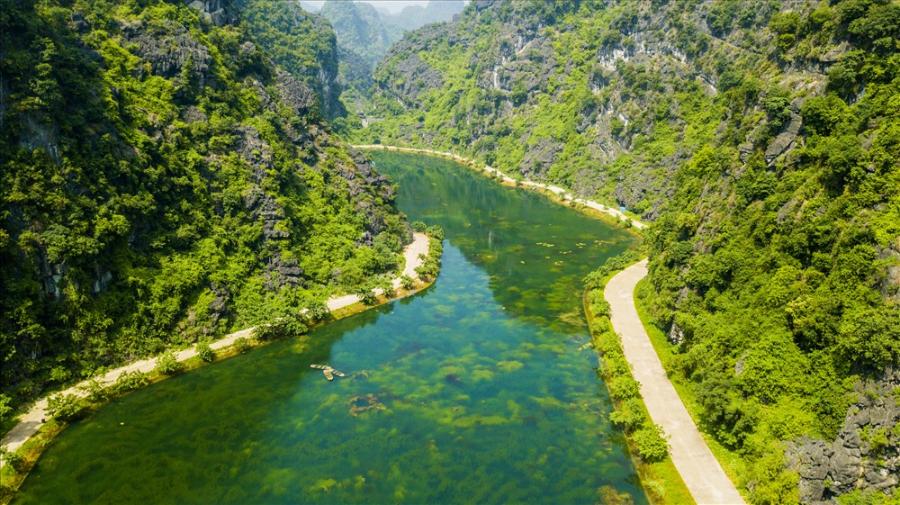
Am Tien Cave exudes a dreamy beauty, like a painting beside the ancient capital (Source: Collected)
5.6. Weaving Stories at Hoa Lu’s Annual Festivals
One of the best ways to experience the cultural vibrancy of Hoa Lu Ancient Capital is by attending its annual festivals, particularly the Truong Yen Festival. Held from the 8th to the 10th of the third lunar month (around March or April), this festival commemorates the reigns of the Dinh and Le dynasties, honoring Kings Dinh Tien Hoang and Le Dai Hanh.
The festival features a grand procession starting at the Hoang Long River and winding its way to the temples of the two kings. Visitors can enjoy traditional ceremonies, martial arts performances, dragon dances, Han script writing competitions, and chess matches. Local villagers also perform plays about the childhood exploits of Dinh Tien Hoang, bringing history to life through storytelling and drama. The Truong Yen Festival is a vibrant celebration of Hoa Lu Ancient Capital’s heritage, offering a unique opportunity to connect with local traditions.
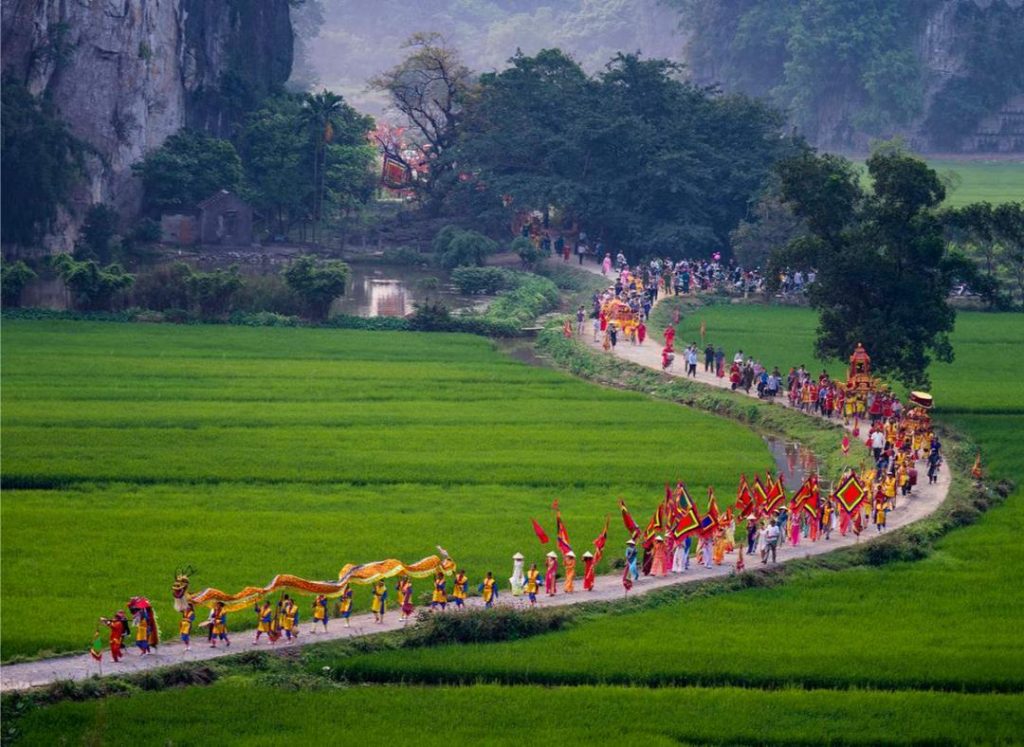
Travel to Ninh Binh in spring to experience the local festivals in Hoa Lu
6. Helpful Tips for Visiting Hoa Lu Ancient Capital
To make the most of your visit to Hoa Lu Ancient Capital, keep these helpful tips in mind:
- Dress Appropriately: As Hoa Lu Ancient Capital is a historical and spiritual site, dress modestly by covering your shoulders and knees, especially when visiting temples and pagodas. This shows respect for local customs and traditions.
- Wear Comfortable Shoes: The site involves a fair amount of walking, and some areas, like Ma Yen Mountain, require climbing steps. Wear comfortable shoes to navigate the terrain easily.
- Bring Sun Protection: Ninh Binh can get hot, especially during the summer months. Bring a hat, sunglasses, and sunscreen to protect yourself from the sun while exploring Hoa Lu Ancient Capital.
- Hire a Local Guide: To gain a deeper understanding of the history and significance of Hoa Lu Ancient Capital, consider hiring a local guide. They can provide fascinating insights and stories that you might miss on your own.
- Combine with Nearby Attractions: Hoa Lu Ancient Capital is close to other popular destinations in Ninh Binh, such as Tam Coc, Trang An, and Bai Dinh Pagoda. Plan a full-day itinerary to explore these sites and make the most of your trip.
- Respect the Sites: When visiting temples and pagodas, maintain a quiet and respectful demeanor. Avoid touching artifacts unless permitted, and follow any posted guidelines.
- Bring Cash: While the entrance fee to Hoa Lu Ancient Capital is low, some small vendors or activities in the area may not accept digital payments. Carry some Vietnamese Dong for convenience.
Hoa Lu Ancient Capital is more than just a historical site—it’s a portal to Vietnam’s royal past, where the echoes of ancient dynasties resonate through time. Let Hoa Lu Ancient Capital captivate your senses and inspire your wanderlust as you explore the cradle of Vietnam’s early civilization.
Plan your trip to Hoa Lu Ancient Capital today with Lux Travel DMC!
